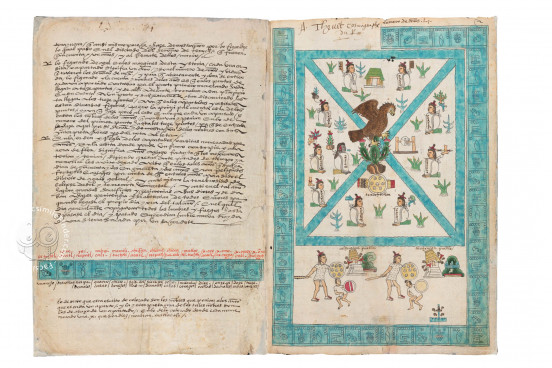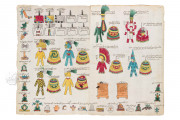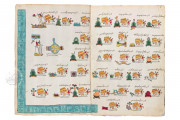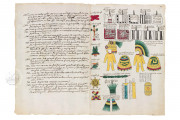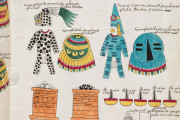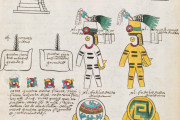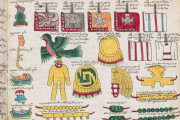The Codex Mendoza is a remarkable product of a concerted effort on the part of the Spanish occupiers of Mexico to record the preconquest culture of the Aztecs. Work on the manuscript probably started in 1541 in the city of Mexico, the former Tenochtitlán, capital of the Aztec Triple Alliance. It records the history of Tenochtitlán, the tributes either collected or expected from the towns of the Valley of Mexico in the early years of the sixteenth century, and the lifecycles of the preconquest residents of the area. All of this is reported principally in pictographs in the pre-Columbian tradition arrayed over seventy-three of its 144 pages, with Spanish-language explanations.
The manuscript's pictographs are attributed to an indigenous painter-scribe, described as "the master of painters" and named Francisco Gualpuyogualcal in a contemporary document. He may have been one of the painter-scribes of the Matrícula de Tributos, created twenty or more years earlier.
A Book Fit for an Emperor
The Codex Mendoza was commissioned by Antonio de Mendoza, Viceroy of New Spain, in 1541, and was destined to be sent to Holy Roman Emperor Charles V, although it never reached its intended recipient.
An Imposing Frontispiece
The first painting of the manuscript occupies a full page and introduces the pictorial history of the empire from 1325 until the conquest. It shows the founding of the city of Tenochtitlán (fol. 2r). The image is dominated by the city's place glyph, an eagle on a cactus atop a rock. The city's network of canals is shown intersecting under the eagle. Two conquered cities are indicated by burning and toppling temples atop stepped pyramids below.
Throughout the manuscript, Francisco drew his pictographs with assurance in black ink. Colors are applied in a nuanced way using a broad palette dominated by light blue, red, ocher, and tan, but also including violets and greens. He may have employed assistants in the coloration of the manuscript's extensive central section (fols. 18-54).
Tribute from across the Empire
The central portion of the codex shows the tribute either expected or received from the thirty-eight provinces of the Aztec Empire to either the central government or the last Aztec emperor, Montezuma II (d. 1520) himself. This content is closely related to that of the Matrícula de Tributos. The goods paid in tribute, all represented by painted vignettes, include ceremonial textiles, battle attire, foodstuffs, and luxury goods.
Child-Rearing and Lifecycles
The last section (fols. 56-71) of the manuscript is an unprecedented and unparalleled account of the Aztec understanding of human life. It traces rituals from birth to death and presents a nuanced understanding of age-appropriate punishments for transgressions on the part of boys and girls. The section concludes with an explication of the rewards of a virtuous life, as well as warnings of the consequences of a life of idleness or crime.
Explanations in Spanish
Many of the pictographs are identified by labels, and the pictographic contents of the manuscript are explicated further in Spanish-language prose, often situated on the page facing the content being described.
Captured at Sea
Although completed in haste to be sent to Spain, the manuscript was captured at sea and ended up in France, where royal cosmographer André Thevet (d. 1592) inscribed his name into the book. Richard Hakluyt (1552-1616), who served as chaplain to the English ambassador in France in the 1580s, purchased the codex and took it to England. It passed through the hands of Samuel Purchas (d. 1626); his son, also Samuel (d. ca. 1658); and John Selden (1584-1654). By the time the Bodleian Library acquired the manuscript in the 1650s it was bound with tables of currency values (fols. 73-84 of MS Arch. Selden A. 1).
We have 2 facsimiles of the manuscript "Codex Mendoza":
- Códice Mendocino facsimile edition published by Instituto Nacional de Antropología e Historia, 2002
- Codex Mendoza facsimile edition published by University of California Press, 1992

